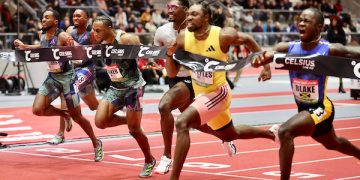Dave Hunter decided to take a shot at explaining some of the strategies in the vertical jumps with passes of heights, and what happens, when you have one attempt left? Do you use it at the height you are at, or do you move up and take a shot a winning or absolutely crashing?
Track & Field’s Chess Game
Subtle Strategies Add Special Intrigue To Vertical Jumps
Track & field is often recognized as being founded upon the concept of running faster, jumping higher, and throwing farther. And for the most part, that’s true. But in certain selected events there is a certain strategic gamesmanship that can have a material impact on the competition.
And that may never be more evident than in the high jump and the pole vault – the vertical jumps. In the throwing events and in the “horizontal” jumps an athlete can essentially win the competition on the first attempt. Shot put star Ryan Whiting might launch a bomb on his initial heave that proves to be good enough to win. Or long jumper Jeff Henderson might hit the board just right and uncork a tremendous, majestic opening jump far enough to ensure his victory.
But except for the extremely rare situation where a winner’s ill-advised delayed entry into a vertical jump event leads to a single jump victory, the high jump and the pole vault are usually extenuated affairs where the athletes know the attempts will likely be many and the crowning  winning clearance will not come until the very end of the competition. “It doesn’t matter when you have your best throw in a throwing event. As long as it is one of your six throws, you don’t care.” notes Shawn Barber, the 2013 and 2014 Canadian national pole vault champion and the Canadian indoor and outdoor national record holder in that event. “But in the pole vault, you have to measure your jumps and have your best jumps at the end of the meet, which can hard for some people.”
winning clearance will not come until the very end of the competition. “It doesn’t matter when you have your best throw in a throwing event. As long as it is one of your six throws, you don’t care.” notes Shawn Barber, the 2013 and 2014 Canadian national pole vault champion and the Canadian indoor and outdoor national record holder in that event. “But in the pole vault, you have to measure your jumps and have your best jumps at the end of the meet, which can hard for some people.”
Real time strategic decisions are crucial in a tightly-contested pole vault competition. When vaulting competitors clear the identical final bar, placing for same-height final clearance contestants are resolved under tie-breaking rules that factor in failed attempts, thus placing a premium on precise, error-free vaulting. So, of course, a vertical jumper wants to vault or jump high – but these athletes also want to avoid failed attempts and minimize jumps in an effort to preserve energy for that winning clearance when the medals are on the line. “When you look at that, you can see why people start coming in a little later in the competition and skipping those first couple bars because it is just one more thing you can have go wrong,” explains Barber in providing insight as to why confident, accomplished competitors often choose to pass at lower heights. “These jumps kind of add up and take a toll on you every time down the runway.”
Savvy high jumpers or pole vaulters understand the importance of meting out energy during a drawn out championship showdown so they have gas in the tank to make that magnificent winning leap at the end of the event when it counts the most. Like other vertical jumpers, Barber attempts to gauge how many top-flight quality jumps he can expect in a competition. “I’ve given some thought to that and I’ve talked to my father [an elite pole vaulter in his day] about it a bit. Usually we figure we can have about 13 good jumps where you haven’t fatigued too much,” the 20 year old reveals. “I don’t do a lot of warmups, so my first couple jumps at bars are my warmups. And that helps me kind of save my energy for the end of the competition.”
But Barber – the 2014 NCAA indoor pole vault champion – is quick to cite the importance of the moment as an additional critical factor in clearance success. “I think it depends what is on the line and what you have riding on it,” observes Barber. “It is all about the energy – the energy in the room, the energy you are feeling. That’s often the difference between you coming down and making the bar or not. On that level, it doesn’t matter how many jumps you have under you. What matters is how much energy you have riding behind you and how much you’re into the meet at that time.”
One way a high jumper or pole vaulter can conserve energy for those critical late-competition attempts at higher heights is to skip lower-height attempts and enter the competition at a more challenging opening height. “The feeling is that it is harder and harder to keep that energy level up the longer the meet goes. Every starts out the meet pumped ready to jump, but then by the end of the meet, everybody is tired and ready to go home,” states Barber.
Barber – whose dual citizenship allowed him in 2012 to set the U.S. national high school pole vault record of 5.57m [18’3½”] while a Texas prep – cites endurance-like training as another way to stave off late-event exhaustion. “I’ve seen people jump all day. I think it goes back to training. Whoever puts in the most time leading up to the meet is generally who wins it,” Barber explains. “I call myself a marathon jumper, because I go out and take 50 jumps in a session several times a week.” The four-time Mid-American Conference vault champion sees these dizzying, repetitive workouts as muscle memory sessions to perfect his run up, his rhythm, his technique – and his endurance. “A little cardio never hurt anybody,” smiles Barber. “It helps when you get into those meet situations where you are taking back-to-back jumps.”
Another pivotal vertical jump strategy is the art of passing to the next height without clearing the current height. Tactical passing not only can help an athlete conserve energy, but moving on to the next height can also be a useful strategy when only a few competitors remain and a later attempt clearance at the present bar will not improve an athlete’s standing in the competition. “For many, it seems complicated to figure out how the earlier misses impact the standings leading up to the bar you are currently jumping and how you are sitting placement-wise because of those misses,” Barber notes. “I am always looking over the clerk’s shoulder checking out people’s position and misses. It is almost second nature for me to add up misses and see where I’m sitting. If I skip a bar here, will it drop me down in the standings? And you’re also reading the other jumpers and figuring out how high they’re going to be willing to jump.”
The importance of keen passing strategy was never more evident than during the pole vault competition in this winter’s NCAA indoor championship. With Barber trailing Ole Miss arch rival Sam Kendricks, Barber elected to pass at 5.70m [18’8¼”] when he couldn’t match Kendrick’s first attempt clearance. It proved to be the correct chess move. With the bar lifted to 5.75m [18’10¼”], Barber rose to the occasion and unfurled a technically-flawless first attempt PR clearance which Kendricks could not duplicate. Now relegated to second place, Kendricks elected not to pass – perhaps a strategic error – and promptly failed to make the 5.75m bar in his final two attempts, thereby sealing Barber’s first NCAA title win. Monday morning quarterbacks might suggest Kendricks should have foregone a meaningless clearance at 5.75m, conserve energy, and have given himself two chances for a clearance at 5.80m [19’¼”] which might have earned him the crown. “In the NCAA meet, nobody goes in to get second place,” Barber explains. “Everybody is doing what they feel they have to do to win it.”
It should be noted that Kendricks returned the favor at the NCAA outdoor championships. Trailing Barber after a first round miss at 5.65m [18’6½”], Kendricks passed to 5.70m [18’8¼”]. He cleared the higher bar on his final attempt. And when Barber c
ouldn’t, Kendricks captured the outdoor title.
The rising University of Akron junior – who continues to make steady PR improvement – is candid on what he believes is necessary to move up to that next level. “I think I need a little more experience and a little more strength,” explains the reigning Pan American Junior pole vault champion. “I’ve been talking to Coach [Dennis] Mitchell about just moving everything up. So when I would start the competition, maybe I would start at 5.35m [17’6¼”] as opposed to 5.20m [17’¾”] which would give me more jumps at the higher bars. So I’m trying to keep edging my way up to get to those higher bars. It [the later entry] is something to push yourself and keep moving up the mountain.”
Barber, who successfully defended his Canadian national pole vault title earlier this summer, has his eye on the prize at an even bigger competition – the Commonwealth Games which will commence later this month in Glasgow. Can the budding vault star be competitive in Scotland? “I hope so,” reveals Barber whose top 2014 outdoor clearance of 5.65m [18’6½”] places him 18th on the world leader list. “It is the biggest meet of the year. I’m looking forward to it.”
To get on the Commonwealth Games podium, Shawn Barber will likely have to turn in a vault performance at or even above his personal best clearance of 5.75m [18’10¼”]. But he also knows his chances for success – to be positioned to make that grand medal-winning jump when the money is on the table – will be enhanced if he makes the best strategic decisions along the way.
~Dave Hunter






















